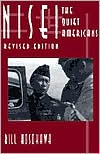This past weekend the Seattle Times had an article about how the Iraqi-bound 34th Division honored Japanese-American members of the 442nd Regimental Combat Team. The 442nd was a Japanese-American unit of the US Army during WWII which highly decorated, while many of the soldiers had families in internment camps at the time.
The present day meeting between the two groups sounded very touching, and the Times reports that happened by chance:
Vietnam veteran Ted Yorita, a former Marine, had been at Fort Lewis for a gathering of color guards when he took a break at the local burger joint. A few tables away, something familiar caught his eye.
It was a patch he knew well, on the shoulders of several lunching 34th Division soldiers. Yorita, a member of the Nisei Veterans Committee, had to ask: Had they heard of the 442nd?
Which, it turned out, was like asking if these guys had heard of their own uncles.
Every now and then I hear WWII-era stories from my family, but I don't yet have a full picture of what happened. I know that my mom's family was first sent to the Santa Anita racetrack and then to Jerome, Arkansas. After that is a bit sketchier for me, but I think they ended up in Illinois where they met Frank and Ada Emerson who were extremely kind to them and would become long-time family friends.
I'm less sure about my dad's family, other than they left the strawberry farm. I know my dad and his brother Easy were in the Army, but I'm not sure about their older brother Mas. It's also not clear to me what they did in the Army, but my dad's told me some stories about what sounded like clerking.
Sounds like I have lots of places I need to fill in family history.
My late uncle Joe Kadowaki was in the 442nd, and among other citations earned a Bronze Star. On his Discover Nikkei page, he says:
At war's end in Italy, after leaving the 442nd in Italy and returning to USA, and the first day on the train to visit my wife and child before reporting for further duty to military intelligence unit and proceeding to the Pacific War, 2 white recruits struck me from behind and said, 'You dirty Jap, hiding behind our uniform.' I was crushed more spiritually than physically.
My first thought was 'Am I coming back to the same hostile atmosphere I faced in California shortly after Pearl Harbor?'
After he left the Army, he and his family finally settled in Ohio where he felt accepted as an equal.

After it had been sitting on my bookshelf for decades, last year I finally got around to reading Bill Hosokawa's Nisei: The Quiet Americans which centers around my dad's generation (my mom is Sansei; her parents were Nisei). Some people call the writing somewhat dry, and while I agree that some parts greatly reflect Hosokawa's journalism background, other parts really came to life and I found reading the book a very moving experience. He goes deeply into life both in the internment camps and at the war's front lines, as well as following specific people from before through after.
I've seen copies of this book on many people's shelves. I'm pretty sure many have gone unread, yet I get the feeling that people trusted Hosokawa's narrative abilities to have bought the book as a way to say "This is what we went through". It's almost as if Nisei were a symbol of solidarity to many Nisei and Sansei. I think it's an important read for people of my generation and younger because it sets up a framework for lots of the stories we hear about "Camp" and life immediately after.
